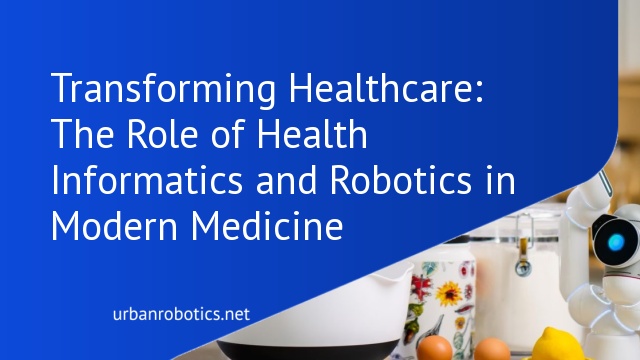Overview of Health Informatics and Robotics
Health informatics uses data to enhance patient care through better decision-making. It involves the collection, storage, and analysis of health data. By leveraging big data, we can identify trends and predict health outcomes.
Robotics in healthcare provides precision and efficiency in medical procedures. Surgical robots, for example, assist with minimally invasive surgeries, increasing accuracy and reducing recovery times. Robotics also includes automated medication dispensers and robotic prosthetics, improving patient mobility and medication adherence.
The integration of health informatics and robotics revolutionizes diagnosis and treatment. AI-driven systems analyze patient data to provide real-time insights and personalized treatment plans. Robotic systems enhance these insights by performing complex surgeries and delivering targeted therapies with high precision.
The synergy between these fields boosts patient outcomes and operational efficiency. For instance, AI-powered diagnostic tools can detect diseases at earlier stages. Coupled with robotic-assisted interventions, these tools lead to quicker, more accurate treatments, ultimately improving patient prognosis and reducing healthcare costs.
Robotics and informatics play a key role in public health. Data-driven approaches help manage pandemics by tracking disease spread and predicting future outbreaks. Robotic devices assist in distributing medical supplies and conducting remote patient assessments, ensuring timely and effective responses.
Advancements in Health Informatics
Health informatics continues to evolve, bringing revolutionary changes to healthcare delivery. We explore key advancements that are shaping the future.
Electronic Health Records (EHR)
EHR systems improve the accessibility and accuracy of patient information. Clinicians can retrieve comprehensive health data instantly, streamlining care coordination. For example, integrated EHRs reduce redundancies and errors in medical records. Advanced EHRs offer features like predictive analytics, which assist in anticipating patient needs and potential health issues. By leveraging such data, healthcare providers can deliver more personalized and efficient care.
Telehealth and Remote Monitoring
Telehealth expands access to healthcare services, especially for remote areas. Patients engage with healthcare providers via video calls, eliminating the need for physical visits. Remote monitoring employs wearables and smart devices to track vital signs like heart rate and blood pressure. These technologies enable continuous patient surveillance, helping manage chronic conditions and identifying issues early. Telehealth and remote monitoring enhance patient convenience and reduce healthcare costs, fostering a proactive approach to health management.
Role of Robotics in Healthcare
Robotics is revolutionizing healthcare by enhancing efficiency, precision, and patient outcomes. Recent advancements in robotic technology focus on key areas such as surgery and patient rehabilitation.
Surgical Robots
Surgical robots assist in performing complex procedures with unparalleled precision. These robots, such as the da Vinci Surgical System, allow for minimally invasive surgeries, which reduce recovery times and minimize complications. Surgeons control robotic arms that provide enhanced dexterity and stability, ensuring consistent performance even during intricate operations. Robotic surgery is particularly beneficial in procedures like prostatectomies, cardiac valve repair, and gynecologic surgeries, where precision is critical.
Rehabilitation Robots
Rehabilitation robots aid patients in regaining mobility after neurological injuries or orthopedic surgeries. Devices like the Lokomat assist with gait training for stroke survivors or individuals with spinal cord injuries. These robots provide consistent, repetitive movements that help retrain neural pathways and muscle memory. By using precise sensors and adaptive algorithms, rehabilitation robots can tailor therapy sessions to each patient’s progress, making the recovery process more effective and personalized.
Integration of Health Informatics and Robotics
Integrating health informatics with robotics is reshaping patient care, combining advanced data analytics with precision-engineering in medical procedures. This synergy presents numerous benefits and challenges.
Benefits of Integration
Enhanced Patient Outcomes, with robotics and informatics harmonizing, enable personalized, data-driven treatment plans. Improved Efficiency, as EHR systems streamline patient data management, reducing errors and time inefficiencies. Advanced Surgical Precision, where robots offer minimally invasive options, improving recovery times.
Challenges and Solutions
Initial Costs can be high, but long-term operational savings mitigate this. Data Security concerns arise, requiring robust cybersecurity measures to protect sensitive information. Technical Complexity necessitates specialized training programs for healthcare professionals.
Future Trends and Innovations
Emerging trends and innovations in health informatics and robotics signify major advancements in healthcare. Adopting new technologies, we can shape the future of patient care.
Artificial Intelligence in Health Robotics
Artificial Intelligence (AI) in health robotics transforms surgery, diagnostics, and patient care. AI algorithms power robotic systems for precise operations, reducing human error and recovery times. For instance, AI-driven robots assist in interpreting medical images like X-rays, identifying anomalies quickly. We see AI enhancing rehabilitation robots, personalizing therapy for patients based on real-time data and progress tracking.
Predictive Analytics and Healthcare
Predictive analytics leverages big data to forecast medical outcomes, optimize resources, and enhance patient care. By analyzing patient records and historical data, predictive models identify at-risk patients, enabling preventive measures. Hospitals use these analytics to predict patient admission rates, ensuring adequate staffing and resource allocation. Predictive analytics improves chronic disease management, helping us foresee complications and adjust treatment plans accordingly.
Conclusion
Health informatics and robotics are revolutionizing healthcare by fostering data-driven decision-making and precision in medical procedures. These technologies enhance patient outcomes and expand access to care. As AI and predictive analytics continue to evolve, we’ll see even more personalized and efficient patient care. However we must address challenges like initial costs and data security to ensure successful implementation. Embracing these innovations will undoubtedly shape the future of healthcare for the better.





